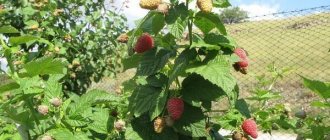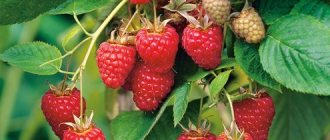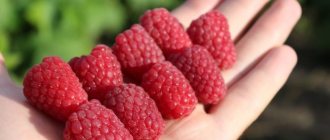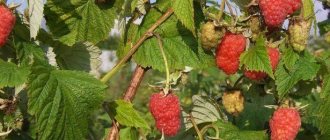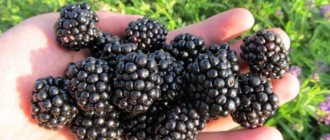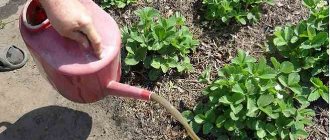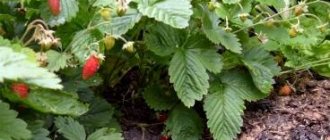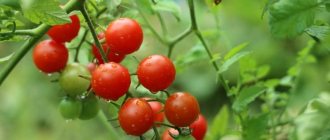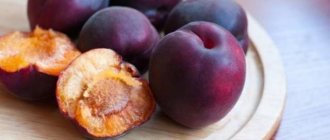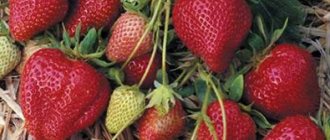Gardeners call the Kirzhach raspberry the pride of their collection. In the garden, the plant is noticeable among other raspberry bushes: the branches are abundantly strewn with berries. Red, inviting, filled with delicious juice. Although raspberries of the Kirzhach variety spread a little aroma, from a distance it is simply lost among other garden smells, but up close you can feel the luxurious bouquet of forest raspberries. There are many berries on the bush: some are already ripe, others are only tinted with the faint pink light of the morning dawn, and behind them you can see still small ones - greenish, but with a hint of future splendor.
Red raspberries of the Kirzhach variety are attractive due to their abundant harvest and long fruiting period. The plant is quite unpretentious, without special care requirements, and therefore Kirzhach raspberries are popular. And the bushes of this plant bring irresistible charm to the garden not only with their lush green-red summer lace, but also with their farewell purple autumn cape. This is exactly the color of the stems of the Kirzhach raspberry variety. Decorative and wrinkled leaves: large, with a beautiful large edge serrated pattern. The tip of the leaf curves smoothly along the central vein towards the stem.
Photo and description of Kirzhach raspberries
Malina is named after a river and a city in the Vladimir region. Obtained at NIZISNP by breeder of berry and fruit crops V.V. Kichina by crossing the varieties Carnival and Malling Promise. Kirzhach took the best characteristics from his “parents” and in 1994 was included in the State Register for the North Caucasus and North-West regions, known for unpredictable weather conditions.
Experimental tests were carried out throughout the country for 10 years. It has been established that Kirzhach grows well in almost any region. You can start a collection of fruit and berry bushes with it. Simple care distinguishes the variety among remontant and early-ripening crops. Compared to later ones, it always has time to mature.
External description:
- Bush. Kirzhach forms a tall bush (from 2.5 meters) with a spreading crown, well developed, powerful, compressed, upright. Forms a large number of young, fruit-bearing shoots. For 1 sq.m. there are over 25 straight, strong shoots. They have lilac thorns on them.
- Escape. Medium thickness, do not sag. They are distinguished by a characteristic waxy coating, are not pubescent, and by September-October they are bright purple.
- Leaves. Oval, jagged, large, wrinkled, strongly curled. This makes the variety an ornamental crop that can decorate a garden plot.
- Fruit. Average weight 2-3 g, shiny, red at the stage of physiological maturity, with small drupes, wide, blunt-conical shape. The pulp is dense. After ripening they have a sweet taste with slight sourness and a slight aroma. Tasting score is high – 4.3 When harvested, they are easily separated from the stalk. Spontaneous falling off is possible with severe overripening. The first raspberries are received in mid-July or later if the region is characterized by a cold climate.
Interesting! The color saturation increases with the age of the plant and with a large amount of sunlight.
Description of the variety
Kirzhach is a mid-season raspberry variety, which was bred by the famous Russian breeder Viktor Valeryanovich Kichina. The variety was obtained by crossing popular raspberry varieties - Moling Promise and Carnival. A distinctive feature of mid-season varieties is their versatility in relation to the region of growth. In most of Russia, remontant and late varieties do not have time to fully produce the harvest; early varieties do not provide raspberries in the second half of summer, so it is mid-season raspberries that will delight you for as long as possible until the fall.
The variety has been listed in the State Register since 1994, so we can safely say about Kirzhach that this raspberry has been tested by time and the description was primarily compiled based on reviews from gardeners.
You might be interested! Description of a high-yielding early-ripening variety of Polish selection - Polana raspberry.
Raspberries Kirzhach were created specifically for cultivation in Central Russia, the North-Western and Volga-Vyatka regions. The variety is also successfully cultivated in the south of Russia because it is resistant to short winter thaws. The only region where Kirzhach raspberries have not taken root en masse is Siberia; this variety does not tolerate frosts well. The Kirzhach raspberry bushes form powerful, more than 200 cm high, single specimens grow higher than 2.5 m. Moreover, the variety is not picky about the composition of the soil, so it will show its best qualities even with a minimum of fertilizing. The shoots of the first year are without pubescence, erect, green; in the second year they are woody. This raspberry has few thorns, so picking fruits and carrying out agrotechnical activities in the raspberry field will not be marred by abrasions or snags on clothing.
The formation of bushes usually begins in the third year of cultivation; this variety produces a lot of root shoots, so propagation is not particularly difficult.
Kirzhach berries are medium-sized, cone-shaped, weighing 2-3 g. The aroma is average, the berries are sweet and sour. The fruits taste like wild raspberries, which is important; they are resistant to self-shedding, so this variety is suitable for gardeners who visit their plot only on weekends. Productivity per bush is 2.5-3.0 kg. The berries are dense and have good transportability. The tasting score of this variety is 4.3 out of 5.0 points.
Raspberry Kirzhach is characterized by good resistance to infection by various diseases and pests. It is worth noting the excellent protection against anthracnose, which is considered the most powerful fungal disease of raspberries, as well as spider mites. What Kirzhach should be treated for is raspberry beetle, curl and root canker.
Advantages of the variety
- the absence of any specific requirements for agricultural technology and soil composition;
- moderate winter hardiness, allowing Kirzhach to be grown over most of Russia;
- high fruit density, making this raspberry transportable and shelf-stable;
- resistance to major raspberry diseases and pests;
- small number of thorns;
- mid-ripening;
- powerful bushes;
- decorativeness of bushes. Beautiful large leaves with a jagged edge and curl perfectly decorate the garden
Disadvantages of the variety
- low resistance to severe frosts;
- possible root cancer disease.
Characteristics of the variety
Kirzhach is a universal plant. It bears fruit well in the North Caucasus, North-Western, Central, Central Black Earth regions, middle zone, Siberia, and the Urals.
Key Features:
- family - Rosaceae genus Rubus;
- method of fruiting – non-remontant;
- ripening period – mid-season;
- flowering and pollination – self-fertile variety. Insects are not needed for pollination, but high yields are achieved by planting other raspberry varieties;
- fruit color – red;
- taste – sweet and sour;
- berry size – medium (2-3 g);
- height – more than 2 m;
- winter hardiness – moderately winter-hardy;
- resistance to anthracnose, spider mites – relative;
- damage factors – root canker, raspberry beetle, overgrowth;
- yield – consistently high, 67-100 c/ha, 3-5 kg per bush;
- low demands on soil fertility.
History of selection
Raspberry Kirzhach was created in VSTISP by crossing the varieties Carnival and Malling Promise, which were especially popular in the second half of the 20th century. The breeding work was supervised by Professor Viktor Kichin, a well-known originator of fruit and berry crops.
Since 1979, the variety has been studied by the Soviet commission for testing and protection of breeding achievements. But the species was officially registered only in 1994. The Kirzhach variety received its name in honor of the city and a small river in the Vladimir region of the Russian Federation.
Advantages and disadvantages
Positive and negative characteristics of culture.
Pros:
- high transportability, shelf life - does not lose external qualities during transportation and storage;
- universal purpose - used for private and commercial purposes;
- the fruits are dense, tasty, with notes of wild berries;
- a good harvest - fully manages to reach maturity in any weather conditions. On average, the bush produces about 3 kg;
- unpretentiousness to soil composition - takes root well on almost any soil;
- easy care - consistently high yields are achieved with a minimum of effort;
- resistance to anthracnose.
Minuses:
- small fruit size - among competing varieties, Kirzhach berries look small;
- poor winter hardiness - in the northern regions the installation of protective structures is required;
- vulnerability of the root system to root cancer, susceptibility to curl (the disease is difficult to treat, the affected bushes will have to be removed).
Reviews from gardeners about the variety
Gardeners speak mostly positively about Kirzhach raspberries.
★★★★★
Valery, 44 years old, gardener. The first raspberry variety that I decided to plant on my summer cottage was Kirzhach.
This was about 10 years ago, when I just bought a dacha. But to this day the bushes delight me with high yields, fruits with good taste. Every year I collect about 2 kg of raspberries from one bush, and I have 15 plants. There is no need to use chemicals, I carry out preventive treatments, so the bushes hardly get sick and are not attacked by pests. ★★★★★
Konstantin, 32 years old, summer resident. I heard from friends about Kirzhach raspberries and decided to plant them on my plot, since the territory allows it.
I liked that the plants require virtually no maintenance - I water them once every two weeks, try to fertilize them and make sure that pests do not attack them. I like such minimal labor costs, because due to constant work routine, I rarely manage to get out to the dacha. Raspberries please with good yield. The wife makes raspberry jam. ★★★★★
Irina, 37 years old, housewife. My husband and I live in our own house.
Since there is enough space, we decided not to waste time on trifles and planted 20 raspberry bushes. On the Internet we came across the Kirzhach variety. We were not mistaken. Although some claim that 3 kg of fruits are collected from a bush, we manage to collect 5 kg from each plant per season. The berries store well and do not release juice for a long time. Hide
Add your review
Raspberry Kirzhach is an unpretentious plant, characterized by good fruiting even in the absence of care. But with regular watering, fertilization and processing, it is possible to increase productivity and get a lot of harvest from the bushes, which is later used for personal consumption or for sale.
0
0
Copy link
Landing
Autumn planting is carried out in the south (late September, early October). In the northern regions it is recommended to do it in the spring - the plant will not freeze out with the onset of early cold weather. In the middle zone it occurs in both autumn and spring. Kirzhach loves sunny areas and reacts poorly to shaded, low-lying areas with strong winds, open hills, and steep slopes.
Soil character:
- rich in nutrients, well permeable to oxygen, moisture, sun, medium, light loams;
- the crop does not grow on clay; in this case, the planting soil is prepared separately;
- does not like acidic soils, although it grows well in slightly acidic ones;
- does not respond well to high groundwater levels - the optimal level is below 1.5 m from the ground.
Peculiarity! The best predecessors are onions, carrots, beets, and garlic. You cannot place cuttings in the soil on which potatoes and tomatoes grew.
To prepare planting material, cuttings are removed from weak shoots. To speed up growth, remove all leaves. Shoots are shortened to 65-70 cm.
3 weeks before planting, the soil should be dug up and fertilized:
- for every sq.m. add 2 buckets of compost or rotted manure, 4 boxes of potassium sulfate, 3 boxes of double superphosphate, ½ bucket of wood ash;
- on clays, add 2 buckets of sand, which will improve the soil structure.
A predisposition to the development of root cancer involves placing bushes at a distance from each other. They are planted in rows, the so-called strip method.
Ideally, the rows are formed from east to west - this way the sun’s rays will better illuminate the leaves and stems, and the crop will ripen at a height of 60 cm from the surface of the earth and above. A trellis is placed parallel to the rows. Installation of pillars is necessary after 3-4 m. 2 thick wires or braided cords are placed on them. The shoots are tied here. From the ground to the top wire, 1.5 m is laid, to the bottom - 60 cm.
Optimal distance:
- in row spacing – 45-55 cm;
- between bushes – 25-35 cm;
- on large areas it is advisable to increase these parameters by 10-15 cm.
- the distance to the neighbor's fence is 1.5 m. Otherwise, the raspberries will run away to another area if the soil there is more fertile.
Planting takes place after completion of preparatory activities.
What to do:
- holes are dug 45*100 cm. The bottom is covered with a layer of overripe compost. Double superphosphate is added on top, sprinkled with a fertile layer;
- The cuttings are planted carefully, straightening the roots. Sprinkling with wood ash will protect the system from the action of microorganisms. If the roots are large, they are deepened so that the buds are located under a layer of soil of at least 3 cm.
- The remaining soil is backfilled, compacted, and watered. The plant is mulched with dry straw, humus or sawdust.
How to plant correctly
Seedlings are planted mainly in early autumn. The best period for the middle zone is September and October. Raspberries will have time to take root before the cold weather. In regions with cold climates, planting occurs in late April or early May. In this case, the plants need to be provided with timely and abundant watering.
Raspberry Kirzhach prefers to grow in well-lit places, protected from gusts of wind. Soils suitable are light sandy loam or loamy. Of course, the best results will be in fertile or well-fertilized areas.
Raspberry Kirzhach reacts negatively to stagnation of moisture at the roots. When planting, avoid lowlands, wetlands and places where moisture accumulates during snow melting and heavy rains.
Attention!
Tall, overgrown bushes can interfere with sunlight access to other crops. Due to the height of the bushes, growing Kirzhach raspberries next to fruit trees is not recommended. Many people prefer to plant seedlings on the south or east side of fences.
Kirzhach raspberries are planted both in holes and in trenches if there are a lot of seedlings. The planting depth is calculated so that the first bud of the seedling is at a height of 3-5 cm above ground level.
- A mixture of soil with rotted compost or humus in a ratio of 2 to 1 is placed in the holes. For poor soils, you can prepare a composition of equal parts of the components.
- Before planting, the roots of the plant are dipped in clay mash or sprinkled with wood ash.
- Tall Kirzhach raspberries are planted at a distance of 70-80 cm from each other. The holes are closed.
- The plantings are watered abundantly and mulched with sawdust.
For the winter, many people use compost as mulch.
Watering
Depends on the climatic conditions of the area and weather. Without properly organized moisture, the variety will lose its characteristics and produce excess growth of leaves and shoots.
Correct watering:
- in dry conditions - once every 10 days (three times a month), especially during flowering. If it is very hot, water more often. The soil under the plant should always be moist, since the roots are located in the surface layer. But there is no need to water too often, this will lead to stagnation of water and rotting;
- early spring – not carried out due to the saturation of the soil with melt water;
- end of May - beginning of June - abundant watering once every 15 days (twice a month).
The horse system goes down to 30 m. It is important to shed the soil to its full depth. In a row planting, the water consumption is 200 liters per 10-meter row. Before watering, loosen the soil - this will prevent the formation of a crust and allow air access to the roots.
Origin story
The variety “Kirzhach” was developed not so long ago and belongs to the class of common raspberries. Registration and description of the variety in the state register dates back to 1994. "Kirzhach" was obtained by crossing the varieties "Carnival" and "Malling Promise". The selection process was led by Professor and Doctor of Biological Sciences Viktor Valeryanovich Kichina.
Read also: Growing raspberries in the country: where and when to plant, planting methods
At the time of breeding, raspberry “Kirzhach” was the only one of all varieties that bore large berries. Now the shrub does not particularly stand out against the background of a wide variety of species.
Initially, the variety was actively grown in the North-Western and Volga-Vyatka regions, as well as in the territories of the North Caucasus and Ukraine. Over time, “Kirzhach” raspberries have become more widespread and can be used in any areas where winters are not very harsh.
Feeding and processing
It is carried out before flowering, during the formation of the ovary, and during the formation of fruits. Organic matter and a mineral leaf complex containing calcium, potassium, some trace elements, and nitrogen are attracted.
Mineral fertilizing is introduced every 3 years. Raspberries primarily need potassium sulfate. Phosphorus (superphosphate) is added every 6-7 years. On sandy soils, the proportion of mineral and organic fertilizers is increased.
Proper feeding will ensure high yield - more than 4 kg per bush, will give a bright taste, sweetness, density, juiciness of the berries.
What to do:
- in the spring - when loosening and cultivating the soil (up to 10 cm in depth), mullein is introduced. Consumption – 8 kg per sq.m. To stimulate stem growth and high protective functions, urea is introduced every year. Consumption – 4 tbsp. for 10 liters of water for 2 plants;
- immediately after planting - after the buds open, the first fertilizing is introduced. The second - after 2 weeks, the third - after another 2 weeks. For a 10 liter bucket take 1 shovel of fresh mullein, 1 tbsp. urea. After mixing, give 1 liter for each bush;
- when 2-3 strong leaves appear – Fufanon 2 g + Ridomil 25 mg per 10 l. The first drug will get rid of curliness, spotting, and fungal infections. The second one will protect against flower beetles, ticks, and gall midges;
- flowering period - boric acid is used. Consumption – 20 g per 10 l;
- when forming berries under bushes, pour nitrophoska, consumption 20-30 g per 10 l;
- the end of fruiting - repeat the Fufanon solution;
- preparation for winter, autumn loosening - a solution of potassium chloride (10-15 g/10 l) or superphosphate (25 g/10 l) is added to the soil.
Features of planting and care
When planting raspberries, preference is given to the spring, but planting in the fall is possible after the end of sap flow in regions with not very severe winters. If Kirzhach raspberries are planted in one row, it is recommended to leave a distance of 0.4 meters between the bushes. When planting in multiple rows, the distance between the rows is 0.5 meters, and 0.9 meters are left for the passage between them (see diagram below).
It is recommended to maintain such significant distances between plants due to the susceptibility of this raspberry variety to root canker.
It is recommended to maintain such significant distances between plants due to the susceptibility of this raspberry variety to root canker. In addition, this will make it easier to care for densely growing raspberry shoots.
When planting raspberries, you should ensure that all of its roots are immersed in the soil at least three centimeters.
When planting raspberries, you should ensure that all of its roots are immersed in the ground at least three centimeters
After planting, it will be very useful to mulch the soil with humus, sawdust or straw.
The upright shoots of Kirzhach do not lodge, but with a length of more than two meters they bend significantly. It makes caring for raspberries very easy with a one- or two-row trellis, along which the shoots of the plant are secured. Wherein:
- ventilation of foliage improves, which reduces the likelihood of diseases;
- The conditions for ripening berries are improved, as their exposure to sunlight increases, and thereby the quality of the harvest increases.
In order for greater branching of the bush to occur with the formation of fruiting organs, when the branch reaches a height of 0.9–1 meter, it is pinched. The timing of this operation depends on the climate and weather conditions of a particular year (beginning of the growing season).
Recent Entries
5 working ways to use tar in the garden 7 indoor plants that help you get married even in adulthood Indoor plants that can bloom in trouble
Wildly growing Kirzhach bushes are normalized, leaving no more than ten branches per linear meter of row for growth and fruiting. Fruit-bearing branches are removed after harvesting. For wintering, they leave a slightly larger number of shoots than 10 per linear meter of row, so that in the spring they can select the most powerful and strong ones.
For the first time in the season, you can feed raspberries with fertilizers containing nitrogen (urea, nitroammofoska and others), in accordance with the instructions on their packaging, while the snow is melting. Water will carry useful elements deep into the soil. This will stimulate the active growth of the plant and its root system.
Before flowering, during the formation of ovaries and the beginning of fruit development, foliar feeding of raspberries with one of the complex fertilizers, which contains calcium, potassium, some nitrogen and microelements, will be useful. You can choose the drug at a garden store; it should be used in accordance with the instructions for use. The juiciness, sweetness and density of the berries are significantly dependent on such processing. This fertilizer can be used for the same purposes for other berry crops.
The juiciness, sweetness and density of berries is significantly dependent on foliar feeding
In places where winter temperatures can drop to -32–35 ºС, it is better to cover Kirzhach with agro-fabric. For regions with milder winters, raspberries winter well under snow cover.
Water the raspberries depending on the weather, but so as to saturate the roots of the plant with it, that is, the soil should be saturated to a depth of 35 cm.
Water raspberries depending on the weather, but in such a way as to saturate the roots of the plant with water, that is, the ground should be saturated to a depth of 35 cm
During the period from late May to mid-June, when the plant's root system is actively developing, it is especially important not to let the soil dry out. Otherwise, in search of moisture, the raspberry will begin to increase the number of shoots in order to absorb it from the air with its leaves. Normal watering in a volume of 20 liters per meter of raspberry row will prevent such developments. It is better to water raspberries at regular intervals from mid-May to the end of August.
After absorbing water, the soil must be loosened, ensuring normal breathing of plant roots.
Garter and trimming
Pruning of branches is carried out in autumn and spring. Before the buds begin to bloom, remove excess shoots. Immediately after picking the berries, affected, weak, diseased, dead, damaged, dry branches and old shoots are removed to the ground. Fruit-bearing shoots are cut down to soil level. You can't leave stumps. The cut is well treated with potassium permanganate, then with garden varnish.
Important! Old fruit-bearing shoots are cut out from the third year of cultivation.
- Kirzhach produces a huge amount of shoots that interfere with the development of the main bushes. It is necessary to mercilessly fight root suckers.
- They are removed with a sharp shovel at a depth of 4-6 cm. Regular care will produce 10-12 replacement shoots from the main bush. Of these, no more than 7 are left.
- Garter is a prerequisite for successful growth. It will save the branches from sagging under the weight of ripe fruits, protect against diseases, and guarantee convenient harvesting.
Reviews of raspberries of the “Kirzhach” variety
Ekaterina speaks positively about the variety: “My acquaintance with this variety of raspberries happened a long time ago. Since then I have been growing shrubs for four years in a row. The raspberries will ripen by mid-summer, I use the berries for jam and preserves.”
Grigory from Samara says: “Raspberries have a good taste and hold their shape and don’t wrinkle in your hands. The bushes winter normally, even without shelter. The soil should not be watered often so that the bush does not become flooded. Otherwise, growing raspberries does not require attention. I advise you to try the variety."
Preparing for winter
The culture does not tolerate frost well. Before the onset of low temperatures in autumn, the soil is mulched with hay, pine needles, chopped bark or sawdust. Layer height – 20 cm.
Protection of the root system from freezing (bending and tying shoots near the ground):
- the bottom wire is fixed on the trellises at a distance of 30-50 cm from the soil layer;
- bent shoots are tied to the finished row;
- During the winter, snow is poured on top of the bent bushes;
- in the spring, as soon as the snow has melted, the bushes are raised.
In severe winter conditions, fences are built based on covering material, moisture-resistant plywood or polycarbonate, protecting the crop from precipitation and strong winds.
Proper planting of seedlings
Even novice gardeners can plant Kirzhach seedlings. To obtain a rich harvest over many years, you will need to follow a number of simple rules.
Planting scheme
The most favorable time for planting Kirzhach in areas with mild winters is autumn, in places with a harsh climate - spring.
Planting scheme
Recommendations for planting Kirzhach:
- bushes are placed in sunny, windless areas;
- there should be no ponds or garden beds nearby;
- the acidity level of the soil should be neutral - no higher than 7.0 PH;
- plant bushes at a distance of 30–40 centimeters from each other;
- leave a gap of about half a meter between the rows;
- sand and humus are poured into a pre-prepared hole;
- the roots of the seedlings are treated with ash;
- After planting, mulch with straw or sawdust.
Diseases and pests
The variety exhibits resistance to anthracnose and spider mites. If poorly cared for, there is susceptibility to other diseases and pests.
Important! Preventive treatment will not hurt if your neighbors' raspberries are sick.
| Problem | Causes | Signs | Treatment, prevention |
| Purple spot is a fungal disease | Close planting, high groundwater table, oversaturation of soil with nitrogen, high air humidity. | Dark spots all over the bush, drying out. | The diseased plant is cut out. During leaf fall in late autumn, iodine treatment is carried out. Consumption – 3-5 ml per 10 liters of water. |
| Raspberry flower beetle - black, oblong beetle | Poor care. | Destruction of buds (wither, fall off). Deep pits and through holes in the foliage. | Before the buds open, they are sprayed with garlic infusion. Take 0.5 kg of cloves for 3 liters of warm water and leave for 5 days in the dark. The product is filtered, 60 ml is used per 10 liters of water. The effect is enhanced by crushed laundry soap (50 g). Spraying frequency – 2-3 times a day. Ready-made insecticides: Kinmiks, Konfidor, Fitoverm. Spraying is carried out according to the instructions during the appearance of buds. |
| Root cancer | Failure to comply with agricultural technology conditions. | A dark swelling the size of a walnut forms on the roots. The bush slows down its development and growth, weakens, and produces small fruits. | For prevention, purchase strong, healthy seedlings. The diseased bush is destroyed by burning. |
Features and Specifications
Raspberries "Kirzhach" do not have any obvious features compared to other varieties. The shrub is widely used by amateur gardeners to obtain berries for personal needs, but not for mass production. The size of the berries is medium in size.
The taste characteristics of the fruit are quite good, but inferior to some types of raspberries. However, this does not make the Kirzhach variety less popular. This can be explained by the ease of caring for the bush and good yield.
If we describe the appearance of the variety, the shrub is characterized as powerful and tall. The length of the branches can reach 250 cm. The shrub belongs to the category of upright plants. The variety is characterized by intensive formation of shoots: about 25 pieces per square meter of area. The stems have a small number of purple thorns.
In the shade the stems have a green tint, but in the sun they turn purple-red. “Kirzhach” bears fruit of medium-large size berries, which have a blunt conical shape. The fruits do not have a pronounced aroma. The soft part of the fruit is sweet, with a slight sour taste.
The shrub is also characterized by abundant fruiting. Raspberries "Kirzhach" are resistant to mild winters and tolerate thaws well. The variety is also undemanding to soil and easy to care for.
Raspberry propagation
Proceeds from root or green cuttings.
In summer, green cuttings are used:
- planting material is cut off at the root and shortened to 7-10 cm;
- to stimulate the roots, dip into a solution of Kornevin or Heteroauxin for 12-15 hours;
- planting is carried out under film or in a greenhouse, against the background of constant air humidity and t 22-25°C;
- constant watering is carried out or a fogging installation is used;
- Rooting occurs on days 30-35. Next, the plant is planted in a permanent place along with greenhouse soil.
In spring, root cuttings are used - part of the root system with a lateral branch. Planting is carried out immediately after separation, preferably in warm weather, when the air warms up to 22-25 degrees. In the first 2-3 weeks, regular watering is carried out. Complete rooting is observed on days 20-25.
Features of reproduction
Like most varieties, Kirzhach raspberries are propagated by cuttings and layering. Cuttings 15-20 cm long with 2-3 strong buds are cut in the fall from two-year-old shoots. Gardeners store them in the refrigerator until spring or plant them in greenhouses for the winter, providing additional shelter. By spring, seedlings with several roots will be ready.
In the spring, layering is placed in prepared trenches, secured with staples and dug in, leaving the top. Planting material will be ready by autumn. However, this method of propagation for Kirzhach raspberries is not entirely suitable. The shoots of the plant are very strong.
Agricultural planting technology
If you follow all the rules and recommendations, you can grow an excellent harvest of fragrant, juicy berries for many years. Let's consider in order what needs to be done for this.
Deadlines
- First of all, focus on the weather conditions and climate characteristics in your region. In the south, seedlings can be planted in the second half of September and until the beginning of October. The seedlings will have time to adapt and take root before the cold weather. In the spring they will immediately begin to actively develop.
- In the spring, it is better not to plant raspberries in the southern regions, since the sun is quite strong, and the above-ground part may begin to develop before the roots take root. As a result, the plant will simply die.
- In regions with a temperate climate, it is better to plant in the spring, as it occurs with heavy rainfall and heat appears slowly, which is suitable for raspberries. In the autumn, seedlings may not have time to take root before the cold weather.
Selecting a location
- Choose a sunny place for the raspberry plant. This is very important for a good harvest.
- You should not grow bushes on the shady side of the site or in partial shade. In this case, the branches will begin to grow strongly and will block the sun from the berries. As a result, the harvest may be late and not abundant.
- It is not recommended to plant the bush in an area where there are strong winds or drafts. Also plant it away from the beds, as the bushes are tall and will create shade.
- If groundwater flows too close to your site, then it is better not to plant raspberries, as dampness, flooding and moisture in the roots will lead to diseases and fungal infections in the bushes. Planting near bodies of water, including artificial ones, is also not recommended.
The soil
Shrubs are particularly undemanding to the composition of the soil. However, it is preferable to plant on loamy soils or black soil. The acidity level should be weak, no more than 5.7 - 6.5 pH.
Follow the rule of crop rotation. It is better for legumes or grain crops to grow on this soil before the raspberries. However, if you want to grow a decent harvest, you will have to apply fertilizers on a schedule throughout the season, starting in spring.
Planting scheme
- It is necessary to make sufficient spaces between the seedlings so that there is no excessive thickening. It is recommended to make a distance of 1.2 - 1.5 m.
- If you plant a lot of bushes, then you need to leave at least 3 m between the rows. Take into account the tall growth and rather dense crown.
- Prepare planting holes in advance. When planting, the growth point should be buried 3 - 4 cm into the soil.
- Install the seedling and sprinkle it with a nutritious soil mixture consisting of humus and sand. Pre-treat the root shoots with wood ash, which will protect the plants from infection by fungal diseases.
- After planting, water the young bushes generously and mulch the soil. Straw, humus or sawdust will do.
Reviews
Gardeners who have been growing Kirzhach raspberries in their garden plots for many years leave only positive reviews about this variety, however, they say that this type of garden berry is only suitable for home cultivation. It is better not to breed this variety on a commercial scale, but to choose something more suitable.
Judging by the reviews, the following conclusions can be drawn:
- The advantages include excellent taste of the berries, an aroma reminiscent of wild raspberries, ease of cultivation and care, good yields, resistance to anthracnose and spider mites, good transportability and shelf life.
- Disadvantages include the small size of the berries, instability to a number of diseases and pests, insufficient frost resistance, and the inability to grow for sale.
Despite all the shortcomings, Kirzhach has been one of the most favorite raspberry varieties among most gardeners for many years and has no intention of losing its position. Beginner gardeners can grow this type of raspberry without any problems. This will not cause them any difficulty.
Diseases
The “Kirzhach” variety is characterized by average resistance to some common plant diseases. The shrub is practically not susceptible to the following diseases:
- damage by spider and raspberry mites;
- disease caused by deuteromycetes.
However, a number of diseases pose a great threat to the bush. Raspberry "Kirzhach" has poor resistance to the following diseases:
- mycoplasma growth;
- damage by the common raspberry beetle pest;
- root cancer.
Mycoplasma growth is expressed by the active pinpoint appearance of weak shoots instead of one strong stem. Such stems are characterized by a small height - up to 30 cm - and a small diameter.
Weak shoots do not develop and do not bear fruit. If this disease occurs, it is recommended to completely dig up the bush.
The raspberry beetle damages raspberry leaves and buds. Pest larvae feed on the pulp of berries. As a result of damage to the flowers, the bush begins to bear fruit poorly, and the berries themselves develop poorly.
Root cancer refers to the category of bacterial diseases that affect the root system. The bush stops developing and bears fruit poorly. If this disease is detected, the affected bushes must be dug up and burned.

